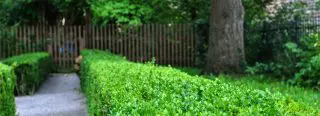Many hedge plants serve as a screen and at the same time a beautiful addition to any well-kept garden. Many of these plants are robust and extremely easy to care for. This also includes the hedge plant Thuja Emerald.
Originally, the Thuja comes from North America and is also known under the name “tree of life”. It is a cypress plant that is available in different varieties. Some varieties of Thuja reach a height of four meters, others bring it to a length of up to 15 meters. The crown also varies. Depending on which Thuja species it is, the crown has either a narrow cone shape, spherical shape or columnar shape.
Since these plants are extremely easy to care for and tolerate pruning, they are especially suitable for the inexperienced gardener. Below you will get an insight into how to care for Thuja Emerald and information on when it is best to plant it.
How to best care for Thuja
Thuja emerald needs a lot of moisture, especially in the beginning. Accordingly, you need to water them regularly – even on the rainy days. When these hedge plants are older and well grown, this is then no longer necessary. They will be able to provide themselves with water. However, you should still water the plants on hot summer days and during periods of prolonged drought. You can help yourself with bark mulch. Put it on the ground under your hedge. It retains moisture and, moreover, it does not evaporate so quickly.
Another important point in the care of thujas is fertilizing. Thuja emerald needs nutrients to grow well, especially in the early days. Furthermore, it will grow much faster if you fertilize it once a year. This will make it stronger and it will survive the winter well. You should fertilize it in midsummer. For this purpose, a fertilizer specifically for hedges, which is available in stores, is sufficient. Make sure that the fertilizer contains a lot of nitrogen and magnesium. Water the hedge plants well after fertilizing.
Like most hedges, Thuja emerald needs regular pruning. In order to obtain the most beautiful and evenly growing hedge, the maintenance pruning should be done when the hedge plants have not yet reached their maximum height. The best time for pruning is spring , before the new shoots grow or the month of June, when there is a break in growth. During these times, the pruning wounds of the hedge plants close more evenly. In winter, you should not cut the Thuja Emerald – especially on frosty days, because this can cause frost damage from the open cuts. Also unsuitable is bright sunshine. The cuts are sensitive to light and burning will occur.
Incidentally, the hedge plants Thuja emerald are hardy plants. Thus, you do not need to take special measures for the wintering of these plants. However, the Thujas must be watered even in winter, if it was dry for a long time. Make sure that you use a frost-free day for watering.
Unfortunately, even these hedge plants are not safe from fungus or bugs. If, for example, you find twigs that turn brown from the outside to the inside or round black-brown fruiting bodies on shoots, this indicates a fungal infestation. Cut back the hedge plants as much as possible and additionally treat the plants with fungicides.
Likewise, various insects can infest hedge plants. These include, most notably, the thuja pine weevil, the thuja leaf miner, and the thuja bark beetle. The first two pests do not cause quite as much damage. They eat young shoots and leaves. The situation is different with the thuja bark beetle. In case of heavy infestation with this pest, the hedge plants may die. Therefore, you should immediately separate heavily infested plants from the others and dispose of them. And continue to carefully observe the still healthy hedge plants for symptoms of infestation.
From when it is best to plant hedge plants.
The best time to plant hedge plants is either spring after the forestry season or autumn. You should not plant Thuja emerald later than October, otherwise it will survive the winter very badly. Make sure that you keep a distance of about 30 to 40 cm between the individual hedge plants. Thus, the individual plants can grow better and are supplied with sufficient nutrients. It is best to add additional humus or peat dust to the planting hole in order to improve the growth of the hedge plants.
It is best to choose a sunny or semi-shady place for your plants. However, they should never be planted in dark areas. Furthermore, you must make sure that there is not too large a tree nearby. Otherwise, your hedge may not get enough water from the ground.
By the way, the suitable soil for these plants is moist, slightly acidic and only slightly sandy. Generally, a swampy soil rather than too dry soil is suitable for Thuja Emerald. Before planting, the soil should be prepared by careful digging. For cultivation of Thujas you can use normal garden soil, enriching it either with humus, compost or peat dust. This will give your hedge plants all the necessary nutrients to grow well and quickly.










